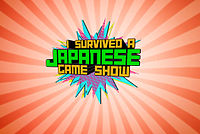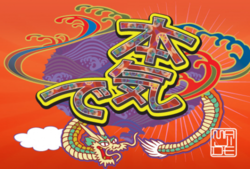- I Survived a Japanese Game Show
-
I Survived a
Japanese Game Show

ABC's promotional logos for Season 1 (top) and Season 2 (bottom).Genre Reality Television;
Game ShowCreated by David Sidebotham;
Karsten Bartholin
(also executive producers)Directed by Kent Weed Starring Tony Sano
(TV host, Season 1)
Rome Kanda
(Majide host)[1]Narrated by Robert Cait Country of origin United States Language(s) English; some Japanese with English subtitles. No. of seasons 2 No. of episodes 15 Production Executive producer(s) Arthur Smith;
Kent Weed;
Tim Cresenti, David Sidebotham, Karsten BartholinLocation(s) Tokyo, Japan Running time 60 minutes Broadcast Original channel ABC Picture format 480i (SDTV)
720p (HDTV)Original run June 24, 2008 – August 5, 2009 External links Production website I Survived a Japanese Game Show (originally titled Big in Japan [2]) is an American reality show that saw its first season premiere on ABC June 24, 2008. The show followed a group of Americans, who leave the United States for Japan where they competed in a Japanese style game show.[3][4] The winner takes home US $250,000.[5] The series won both the Best Reality prize and the overall prize at the 2009 Rose d'Or ceremony.[6]
Season 2, which was supposed to have premiered on July 8, was moved up to June 17 at and debuted that night at 9PM EDT/PDT. The rating is TV-PG (L) for all shows.
Due to the second season having only half the ratings of the first season, ABC canceled the show in 2010.
Contents
Format
In Season One, contestants are informed that they are to take part in a reality-style competition, but not informed of the nature of the show. They are flown to Tokyo, Japan, and taken to the Toho Studios, where it is revealed that they are to compete on a Japanese game show called Majide (本気で). For Season Two, Majide host Rome Kanda surprised each of the contestants in their hometowns informing them they were going to Japan. They are broken up into teams and, in the first six episodes of Season One and first seven episodes and the first half of the final episode of Season Two, competed in games against each other. The winning team was given a reward activity while the losing team was given a punishment activity. In the second season, the first game played saw the winning team have an advantage into the second game, where rewards and punishments were handed out afterward. In the final episode, the first two games reverted to the rules of Season One. Two members of the losing team are chosen to compete in an additional game head-to-head where the loser of that game is eliminated. (In general, the losing team chooses its two players as a team, although in the event that they fail to come to a decision, their opponents make the selection for them.) If the losing team has only two players remaining, then both have to compete in the elimination game. In the final part, the teams are broken up and the four remaining players face three elimination challenges in Season One, and final three facing two elimination games in Season Two; in all cases, the losing contestant was eliminated from the show and carried offstage and sent back to the United States by the "sayonara mob" (脱落者决定), dressed in black suits.
The series followed not only the Majide competition, but also the contestants' activities backstage and outside the game show in reality style. The contestants lived in a house together in the suburb of Kasai, with a Mama-san (Kozue Saito), who generally expects the contestants to live in line with Japanese culture and customs. In season 2, they live in the Majide Guest House with Mama-san.
The host of season one was Japanese-American Tony Sano, whose additional television credits include MTV Spring Break Japan and a recurring role on the The CW4Kids series Kamen Rider: Dragon Knight.[7] About the show, Sano commented, "It's going to be like nothing American audiences have seen on network television." (Matt Hurwitz, Associated Press)[8] Episodes are narrated by Robert Cait.
The show was produced by A. Smith & Co. Productions (the producers of Gordon Ramsay's Hell's Kitchen and Kitchen Nightmares in the USA) with Arthur Smith, Kent Weed of A. Smith and Co. and Tim Cresenti of Small World International Format Television as executive producers and Weed directing, and is distributed by Disney/ABC's Greengrass Productions division. The format was created by Danish producers Karsten Bartholin and David Sidebotham for Babyfoot ApS, and was originally titled Big in Japan.
Majide
Majide (which is Japanese slang for "Seriously?!"), the show-within-the-show, was not an actual Japanese game show, but was intended to resemble what a stereotypical Japanese game show is like.[9] The American producers watched hours of these Japanese game shows, took the most common elements and created all of the games, with help from producers in Japan, who also produced the game segments at Toho Studios.[10] In contrast to many American game shows, which are usually based on either trivia (such as Jeopardy!) or mental skill (like The Price Is Right), Japanese game shows tend to be more physically oriented, such as Takeshi's Castle. The Nickelodeon game show Double Dare was a hybrid of both the American and Japanese styles, while the reality show format also used a strategy base for who to eliminate, and who to keep such as Big Brother and Survivor.
Majide is hosted by Rome Kanda[11] and judged by Masahiro Hurugori, known on the show as Judge Bobu (Bob). Kanda has translated "Majide" (マジで) as "You've got to be crazy!"
Seasons
Season One
Main article: I Survived a Japanese Game Show (season 1)The first episode premiered on ABC on June 24, 2008. Tony Sano was host for this season. There were ten contestants in the first episode, with only one team game per episode. The season ran for seven episodes (unlike the second season) and the last episode screened on August 6, 2008.
Season Two
Main article: I Survived a Japanese Game Show (season 2)The second season premiered on June 17, 2009. Tony Sano did not return to host. In addition, the number of contestants increased from ten to twelve, and there are two team games per episode instead of one. The team that wins the first team game is given an advantage in the second, while the rest of the format remains the same. It ran for eight episodes and finished on August 5, 2009.
It was announced that ABC did not renew the show for a third season on March 5, 2010.[12]
International formats
Besides the USA, fifteen other countries have bought this format.[13] The American version of this show is airing in Australia on 7Two, Denmark on TV3, New Zealand's TV2, Poland's AXN, Singapore's Channel 5, the Philippines' Studio 23, Sweden's TV6, Slovenia's TV3 Slovenia and Portugal's SIC Radical. The Greek version of the show (under the original name Big In Japan) airs on Alpha TV. In Malaysia 8tv, Fridays 10:30pm, Brazil [People & Arts] 22:00. And South Africans see the show on Animax.
Other versions
Greek
In 2009 and began airing with the title Big in Japan.The host was Kalomoira,a Greek singer,and Yoshi Amao.The show was produced and aired by Alpha tv in 1 February 2009.In the show took part 15 Greek persons and they competing each other.
Sweden
In 2009, Sweden began airing its own version of the show called Hjälp! Jag är med i en japansk TV-show (Help! I'm in a Japanese television show) with Swedish celebrities competing against each other. The show was produced and aired by TV4.
The Swedish version was also recorded in the Toho Studios but didn't include Tony Sano, Masahiro Hurugori and Rome Kanda. Instead, the show was narrated (and sometimes hosted) by Carolina Gynning. The show-within-the-show was not Majide, but Do Konjo and was hosted by Yoshi Amao with Mr. Fu as the judge.Contestants
- Kjell Eriksson (radio host) - winner of "Hjälp! Jag är med i en japansk TV-show"
- Klasse Möllberg (musician, actor) - runner-up
- Regina Lund (actress, singer) - third place
- Sandra Dahlberg (artist) - 5th eliminated after episode 8
- Johannes Brost (actor) - 4th eliminated after episode 7
- Dogge Doggelito (artist) - Left the show after episode 6
- Anna Book (singer) - 3rd eliminated after episode 6
- Marie Picasso (singer, model) - 2nd eliminated after episode 4
- Tore Kullgren (TV-profile) - 1st eliminated after episode 1
The winner of the final episode of "Hjälp! Jag är med i en japansk TV-show" was Kjell Eriksson, against runner-up Klasse Möllberg.
Norway
A Norwegian version of the Swedish format has also been aired by the Norwegian network TV3
Portugal
In late November 2009, Portuguese TV station TVI, aired their own version of the series called Portugal de Olhos em Bico. It only lasted for 2 episodes, and it's unknown if it was canceled or if those 2 episodes were the only scheduled ones.
This version had major changes. The contestants didn't travel to Japan, instead they played the game on a TV studio in Portugal. Also, the contestants consisted of 3 teams of 2 members each, and those members were family/friend related. Every episode the teams were different, and they played several games. In the end of that episode, the team with the most points overall, was the winner.
References
- ^ What's New from Rome Kanda's official website
- ^ SmallWorld IFT
- ^ "Show: "I Survived A Japanese Game Show", ABC, June 24"". The Los Angeles Times. http://www.latimes.com/entertainment/japanesegameshow,0,7567983.photo.
- ^ Chuck Barney (2008-06-04). "Summer TV preview". The Mercury News. http://www.mercurynews.com/tv/ci_9473607.
- ^ I Survived A Japanese Game Show
- ^ "Rose d'Or Winners 2009" (PDF). Rose d'Or AG. 2009-05-06. http://www.rosedor.com/downloads/RdO_Winners_2009.pdf. Retrieved 2009-05-05.[dead link]
- ^ (www.tonysano.com)
- ^ The San Francisco Chronicle. http://www.sfgate.com/cgi-bin/article.cgi?f=/n/a/2008/06/23/entertainment/e154053D23.DTL&feed=rss.business.[dead link]
- ^ I Survived A ‘Japanese’ Game Show | Japan Probe
- ^ Q&A: Tony Sano of I Survived A Japanese Game Show
- ^ "J!-ENT SPECIAL INTERVIEW with ROME KANDA by J!-ENT's Dennis A. Amith". http://www.nt2099.com/J-ENT/INTERVIEWS/rome_kanda/romekanda.pdf. Retrieved 2008-09-19.
- ^ Wipeout renewed for third season, but I Survived a Japanese Gameshow won’t return, 22 July 2009, http://www.realityblurred.com/realitytv/archives/abc/2009_Jul_22_wipeout_renewed_gameshow_out, retrieved 23 April 2010
- ^ Babyfoot Aps web site.
External links
Categories:- 2000s American television series
- 2008 American television series debuts
- 2009 American television series endings
- American reality television series
- American Broadcasting Company network shows
Wikimedia Foundation. 2010.

